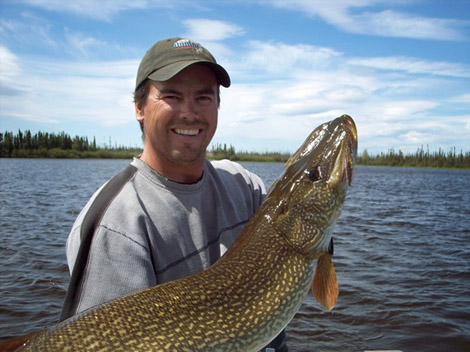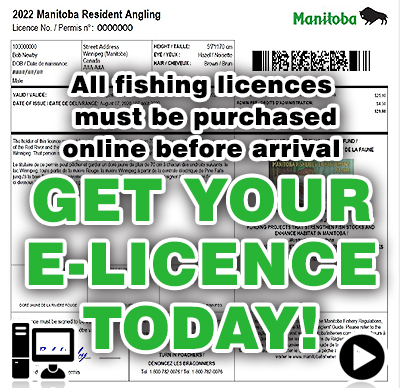Pike Fishing Tips
1) When casting for pike, keep your eyes on or behind your lure and your lure in the water all the way up to the boat. In the 28 years I've been guiding for pike, I've seen many people lose or miss big fish because they were not paying attention. Pike love to follow, many times striking only a few feet from the boat.
2) Polarized sunglasses, yes that's it. Don't come pike fishing up here without them. These glasses take the glare off the top of the water allowing you to see into the water a lot better. Without them, you miss half of the action as pike tend to follow and often strike within your sight. With polarized glasses you will be able to see the follows better as well as which pike to cast at when you're in a shallow bay full of fish. You will catch more fish and be a better fisherman. As a professional pike fishing guide these kind of glasses are a very important tool, and I would not be as successful without them.
3) This pike fishing tip is pretty simple but very important - keep your hooks sharp. A good sharpening tool should be in your tackle box all the time. The sharper your hooks are the more fish you will catch. It will also be a lot easer to set the hook which puts a lot less stress on your fishing line and rod.
4) Quite often, when sight-fishing for pike you get to see the fish before you cast. When this happens, throw your lure past the fish and when your lure is coming by the pike keep your eyes on the fish to see what the fish's response is. The way it responds plays a big part in how to work your lure.
For example, if the fish points straight at the lure and only comes in slow, stop retreating, let the lure drop to the bottom and give it a few twitches.
Keep trying different techniques (i.e. changing speeds, action, twitching, S) until the pike starts coming in fast on the lure. When this happens don't stop doing whatever it was that turned the pike onto your lure.
5) Looking for a good pike fishing rod can be a lot of fun and can also be a little confusing at times. There are so many different kinds, makes, and sizes to pick from. Which one is the best? Well, you want to match the rod to the size of fish you're going to catch. If you're coming fishing with us, you're going to catch a lot of big pike, so when picking up your rod for the trip you want to make sure of a few things first:
· Medium to heavy with a good back bone. To check the back bone you hold the rod by the handle firmly with one hand and with your other hand push down on the rod between the handle and the first eyelet. It should be solid with only a little bend in it, if it is easy to bend and very flexible at this part I would leave this rod on the shelf.
· The more eyelets the better. Most good rods have at least 7, however 9 or 10 is better.
· A good sensitive tip will help you feel things better.
· And the length should be at least 6'6". The longer rods have a few advantages. One being, when the pike runs under the boat you can get the longer rod deeper in the water faster so your line doesn't rub along the bottom of the boat. I've seen hundreds of trophy pike lost because the line gets cut on the boat.
6) When you come fishing in July and August, you will spend some of your time fishing in cabbage weed beds. You can fish these weed beds with regular lures until they become too thick to fish. Then you would need weedless lures like the Johnson Minnow®. When you're going to be fishing these beds, you want to use a fishing rod and line that is a little heavier than you normally would use. Many times when you hook up with a big pike, it will take off under the weeds and turn. If you don't have the heavy equipment to keep the tension on the hook, your hook will come back with nothing but weeds. With a small rod and line it may feel like you have a lot of pressure on the fish but really the weeds will take up the pressure and the hook will become loose and easy for the pike to spit it. Your hook may also catch on the base of the weeds and get pulled out of the fish's mouth, potentially causing you to lose a trophy fish.
7) When you are fishing for the really big pike you need to have the proper size hook on the back of your lure. This is very important as the wrong size hook can cause you to lose the fish of your dreams. You need a good sized hook that will catch the jawbone, or a larger part of the mouth. The smaller hook will only get a small piece of meat and many times tear the soft tissue when the pike takes a run.
8) Have the tools ready to use. It is essential to get the hook out as fast and as safely as possible to ensure the highest survival rate for the fish. Having the right tool to do a good job and having them ready to go isvery important. When you have a big pike on the line the other person inthe boat can start to get things ready to use. Long needle-nose pliers, hook out, measuring tape, camera and the release cradle are the basics.
9) Keeping the fish alive? Once the fish is in the cradle, leave it in the water and have one person hold the cradle open as the other one removes the hook. Once this is done get the camera and make sure it is working before lifting the fish out of the water. After the picture has been taken put the fish back in the water as fast as you can. The fish might be a little tired after the fight and may need a little help to get its strength back. Make sure to take a few minutes to hold the fish upright in the water and move its tail side to side.
Also make sure to get enough water flowing through its gills until it takes off on its own. Most of the fish that die is caused by keeping them out of the water too long after a long fight and not spending the time to revive them. The rewards of seeing that big pikes wim away strong far outweigh the extra minute of fishing you might get by just throwing them back.
Fishing in Cabbage Beds Tips
10) When fishing in cabbage beds, keep the casts short.
Yes, this is true, the best way to keep control of your lure is with a shorter cast. It is a lot easier to maneuver your lure between the weeds with a shorter cast. You don't need the long cast like you do in a clear shallow bay where the pike might be spooked by the boat. Place a shorter cast at one end of the cabbage bed then move the boat over it and continue to cast as you work your way through the bed. The pike are not spooked by the boat as much when they are in the deep weeds.
With a shorter cast you will get a better hook set, increasing your chance of a better hook-up. With a long cast, if a big pike hits your lure he will run deep into the weeds and then you will also have the drag of the weeds pulling at your line when you go to set the hook.









